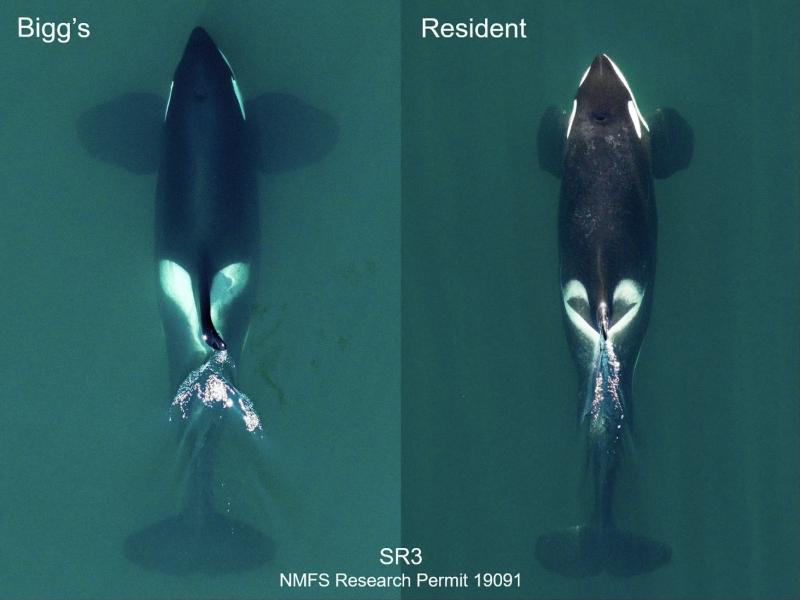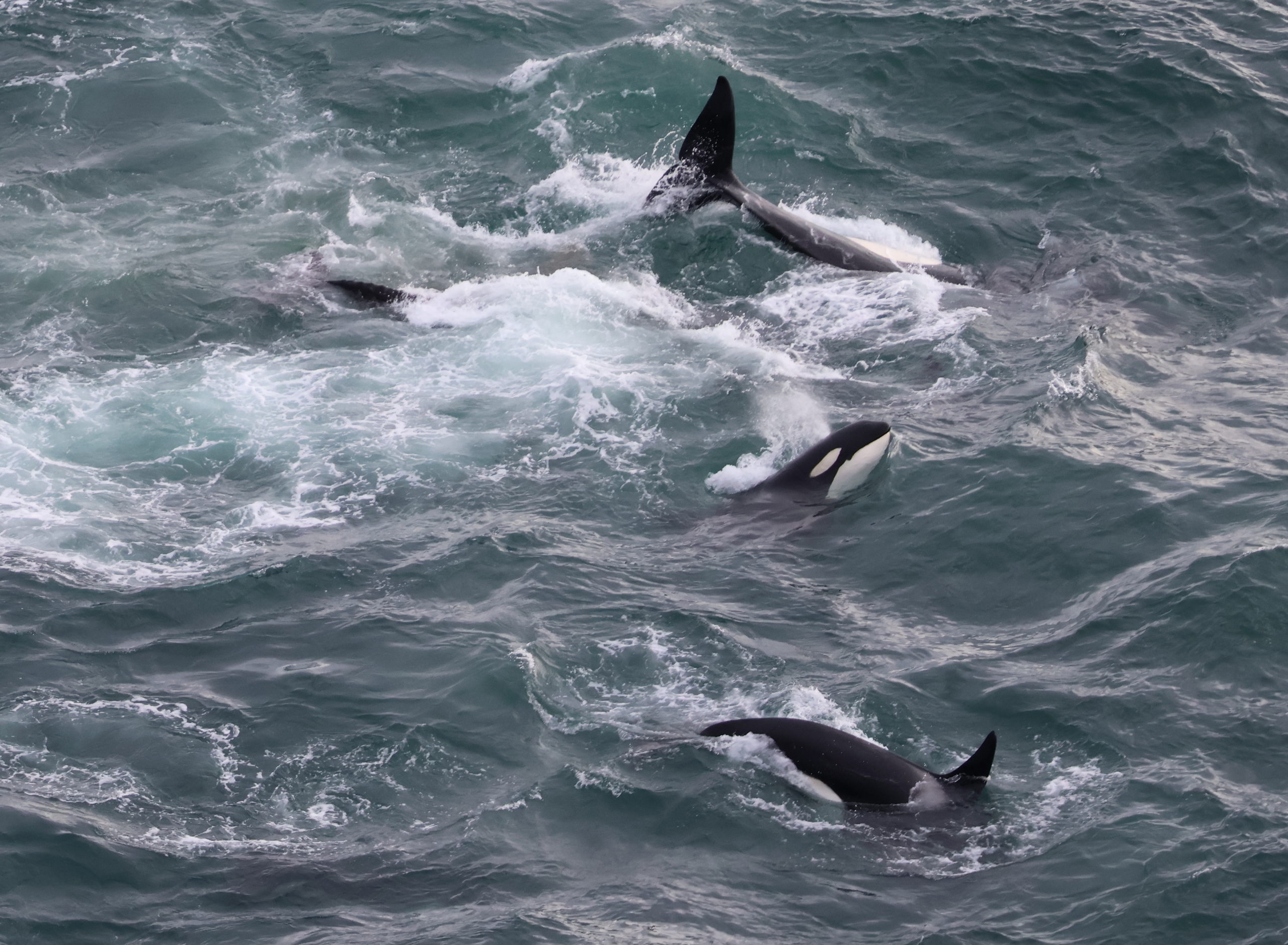
By DANA TIMS/YachatsNews
Up and down the Oregon coast, harbor seal pupping season is just getting underway.
And while the sight of the small, helpless seals is arresting all by itself, it portends another annual marvel – the increasingly visible return of killer whales to the state’s bays, inlets and near-shore coastal waters.
The seals may be cute, but they are also breakfast, lunch and dinner for killer whales. And where you see seals, you’re likely to see orcas.
“For a lot of people, seeing killer whales for the first time can be a life-changing experience,” said Julie Conrad, a longtime Yachats resident with an extensive background in marine science. “It’s such a special thing to be part of.”

This year, more than any before, will likely provide increasing numbers of people the chance to view killer whales, whether they are foraging, attacking migrating gray whales or just cruising to their next destination, said Conrad, who helps administer a wildly popular Facebook page dedicated to posting real-time reports of new whale sightings.
The page, titled “Oregon Coast Killer Whale Monitoring Program,” is private and limited only to Oregon residents. Still, started only two years ago by Josh McInnes, a University of British Columbia marine ecologist whose work focuses on killer whales on the West Coast, the site has already roared past 10,000 members.
Those kinds of numbers amount to a veritable legion of citizen scientists, whose near-daily postings guarantee that anyone who has sufficient interest in seeing and following killer whale activities will strike orca gold.
“For the longest time, Oregon wasn’t even on the map when it came to the scientific community’s tracking of killer whales,” Conrad said. “Now, thanks to many efforts, including this one, they are really taking things a lot more seriously in Oregon now.”
McInnes agrees.

“We are amassing a huge amount of data that helps us understand how killer whales behave up and down the Oregon coast,” he said. “And having so many eyes on the water is a big, big part of allowing us to accomplish that.”
Photographs posted to the Facebook page now allow McInnes to identify specific members of specific killer whale pods, based on distinctive markings on both their dorsal fins and on the saddle patches immediately behind their dorsal fins.
“We live in a time when camera capabilities are just so incredibly advanced,” he said. “Often, one good image is enough to tell us exactly who it is we’re looking at.”

Two new species?
This year’s killer whale watching season is accompanied by some intriguing new scientific research, which asserts that the two types of killer whales that most commonly populate the waters off Oregon and Washington are, in fact, completely separate species.
A new paper, published in the journal Royal Society Open Science, shows that Bigg’s killer whales, sometimes called transients, and Southern Resident killer whales likely diverged more than 300,000 years ago and represent opposite ends of the killer whale family tree.
Although they live in proximity to one another and literally see each other all the time, Bigg’s and Southern Residents occupy different segments of the Northwest marine ecosystem.
The question that drove the new research focused on whether Southern Residents – whose numbers off the Oregon coast are now estimated at less than 75 – were distinct enough to merit endangered species protections, said Eric Archer, a co-author of the paper and leader of the Marine Mammal Genetics Program at NOAA’s Southwest Fisheries Science Center.
“Ours is the first paper that proposes with good evidence a major taxonomic revision to the species,” he said, referring to the way biological species are grouped and categorized. “And, secondly, we are saying that two new species are distinct from the larger set of what we know as killer whales.”
Southern Resident killer whales, for instance, travel in close-knit family pods and prey primarily on salmon and other marine fish. Their pods typically consist of anywhere from 10 to 25 individuals and their dorsal fins have rounded tips.
Bigg’s killer whales, meanwhile, keep their numbers smaller, travel over a wider range and subsist mainly on other marine mammals such as seals, whales and porpoises. Their dorsal fins are generally pointed.
“To survive,” Archer said, “they have both gone off along different evolutionary paths and no longer breed with each other.”
The paper will now be reviewed by the taxonomy committee of the Society for Marine Mammalogy. Archer said a final adoption of the two-new species research could come as early as this summer.

Whale of a show
Experts offer a number of hints and tips for anyone wanting their own view of a killer whale this year.
Of course, Oregon residents can join the Oregon Coast Monitoring Program’s Facebook site and feast on any number of high-resolution photographs and videos of whales gliding along the coast or up into bays at Newport, Florence, Coos Bay and elsewhere.
One attack by a group of 11 transient killer whales on a gray whale mother and her calf last May, for instance, generated countless photographs and led to dozens of people flooding to cliffs above Boiler Bay north of Newport to watch the three-hour-long event.
Some members of the Facebook page, living in central Oregon and other inland areas of the state, later reported that they watched from their living rooms, transfixed by an attack that left the calf dying and its mother either dead or driven off.
But the real payoff, many say, lies in an actual sighting. And for that, there are number of things to keep in mind to make an outing all the more memorable by an eyewitness glimpse.
Conrad, who estimates she has anywhere from 18 to 20 killer whale sightings under her belt, offers these sighting tips;
- “If you want to see killer whales, find a high vantage point to see farther out,” she said. “Lighthouses and many state parks along the coast provide excellent vantage points.”
- Keep a sharp eye out for flocks of birds, she added, which commonly follow killer whale pods looking for scraps.
- Shoreline areas that are used by seals and sea lions as haul-out spots are also rich with opportunity, since killer whales usually know just what they are looking for when it comes to that next meal.
- “And if you see seals and sea lions hurrying out of the surf,” Conrad said, “that’s a special sign that killer whales are probably nearby.”
Plenty of patience, along with several layers of clothing, a camp chair and snacks and water are all extremely useful, since killer whales can hold their breath for up to 17 minutes as they circle and dive looking for prey.
“In the end, a killer whale sighting is more than worth the wait and trouble,” said Conrad, who usually jumps in her car and drives for up to 45 minutes as soon as she gets word that a pod is, say, heading south from Lincoln City toward Boiler Bay or some other popular orca gathering spot. “It’s just a tremendously powerful thing to be part of.”
A note of caution
Leigh Torres is an associate professor at Oregon State University’s Marine Mammal Institute in Newport. She welcomes information provided by citizen researchers, saying it “facilitates data collection and increases our knowledge of where these whales go and who they are.”
A concern for her, however, are reports of increasing numbers of whale-watchers in boats who, in their own excitement, may get too close to killer whales and interfere with their hunting and foraging.

“It’s important to remember why they come into bays in the first place,” Torres said, “and that is to find food. If we are disturbing those efforts by making too much noise with boats, that is going to terminate their food search, which will definitely hurt their health.”
She urged boats to abide by existing marine regulations, that say no craft should come within 100 yards of a marine mammal.
The use of drones has dramatically increased researchers’ ability to get out to where killer whales are maneuvering, Torres said. But feeding behaviors can also be affected by drones, which is why OSU researchers and anyone else should keep their drones at least 25 yards away from killer whale pods.
“We are continuing to learn more and more about these amazing animals,” Torres said. “Following some common sense steps to protect them will, in the end, benefit everyone.”
- Dana Tims is an Oregon freelance writer who contributes regularly to YachatsNews.com. He can be reached at DanaTims24@gmail.com



Thank you for the valuable information. This is my first time visiting this site and I usually watch the resident orcas from Elliott Bay because I live right downtown Seattle and it’s just amazing to see some of the best activities like when they breech and jump out of nowhere. I’m always looking for more activities and definitely from a distance.